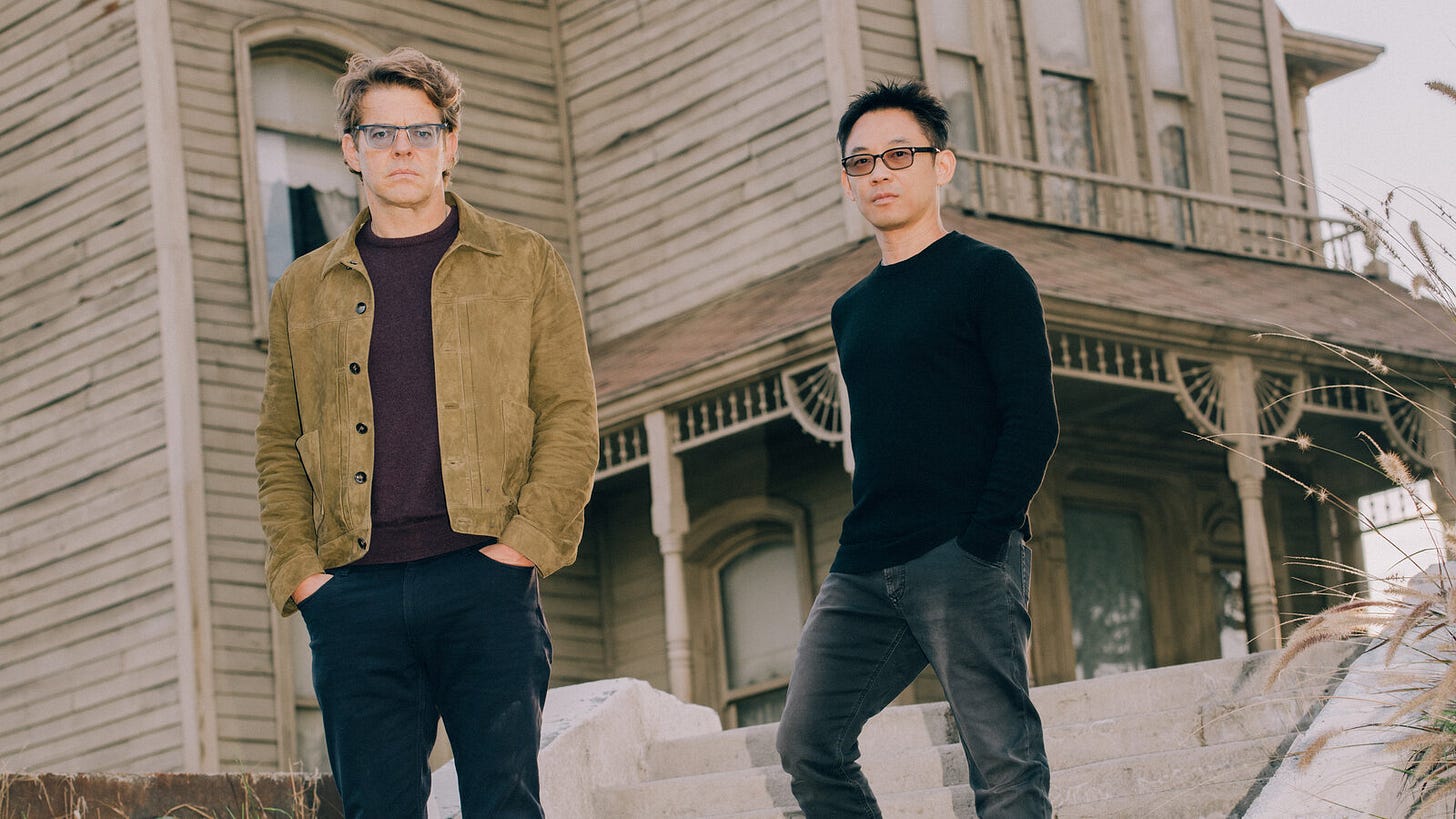Renegades | Abhijay Prakash on Fear, Film, and Future-Proof Representation
The President of Blumhouse opens up about championing bold stories, supporting Asian talent, and redefining what it means to lead in Hollywood.
Welcome to Renegades, Gold House’s editorial series spotlighting Asian Pacific leaders and creatives who are carving their own paths and defying stereotypes along the way. This week’s Renegade is the President of Blumhouse Abhijay Prakash!
A seasoned Hollywood executive and long-time friend of Gold House, Abhijay leads Blumhouse, THE iconic home of horror across film, television and gaming. Blumhouse’s latest film, the highly anticipated sequel M3GAN 2.0, arrives in theaters June 27: get your tickets now!
We ask all our Renegades: what did you want to be when you were growing up, and how does that compare to where you are now?
Well, once I moved on from the fantasy of being starting forward for the Celtics and disappointed my Indian parents by not going to med school or becoming an engineer, I had considered putting my analytical skills to work as an economist working in public policy. I got as far as enrolling in a PhD program before deferring to move out west and pursue a career in entertainment. So to end up running an entertainment production entity is a bit of a left turn from where I started! But the common thread was always seeking to put my skills to use in a product or service that requires being thoughtful, that engages people, and that has an impact on the world.
Horror has long served as a metaphor for collective fears; films like Get Out confronted racial injustice head-on, while Godzilla originated as an allegory for nuclear devastation. How do you see Blumhouse using horror to explore and expand space for stories from underrepresented communities, including Asian voices? Are there any current or upcoming projects you’re particularly excited about that carry forward this tradition of socially conscious genre storytelling?
Some of the best horror says something deeper about who we are. I think we’ve seen that in the response to Sinners this year, just like we did previously with films like Get Out or going back to Rosemary’s Baby or George Romero’s Living Dead films. All those examples are reminders that it starts with the filmmakers. At Blumhouse, we don’t have a specific storytelling agenda within horror beyond supporting filmmakers to realize their passion. We feed off that excitement and are eager to collaborate to bring those visions to the screen — to scare and thrill audiences.
We have multiple projects that fit that bill, including some touching on Asian mythology that I’m excited to see progress. And, of course, since we merged with Atomic Monster last year, we now have James Wan as one of our leaders. James is a once-in-a-generation creative talent and full-on horror mastermind. Every movie James does is an event, and I cannot wait for his next one.
Despite its cultural impact and ability to tackle complex social themes, horror is still often overlooked by major awards and critics. As someone helping to shape the genre at Blumhouse, how do you view this disconnect between critical recognition and audience resonance? Do you think the industry is beginning to shift its perception of horror as a serious cinematic form?
Luckily for us, the rewards and recognition we prioritize come from the audience and from enduring longevity of the films. I think the audience is often ahead of the industry, but horror is gaining in reputation and credibility. There is an undeniable quality of work and supremely talented storytellers working in horror. In the last decade alone, you have directors like Guillermo del Toro, Ari Aster, James Wan, Jordan Peele, Lee Cronin, Coralie Fargeat, Olivia Wilde, Robert Eggers, Scott Derrickson, Steven Soderbergh, and so many more making exceptional genre films.
Second, horror has sustained relevance as a theatrical genre, where audiences actually show up in theaters for the experience. As the most vibrant genre for original theatrical storytelling, I cannot think of a more urgent domain for filmmakers. The critical press is catching up to that. Finally, the horror genre itself is evolving and changing. It’s incredibly dynamic and cannot be dismissively confined to a narrow storytelling ghetto. There are so many subgenres within horror that it’s not just one thing anymore. I mean, what is Tár if not at least partly a ghost story?
We’re seeing a generational shift in how audiences consume content, from TikTok to binge-watching to immersive experiences. How has Blumhouse uniquely approached these changes from a development or strategic perspective?
To reach our audience, we have leaned into platforms and formats that reflect how audiences engage with content today. M3GAN is a great example — we embraced TikTok early, and the viral dance clip became a cultural moment that helped drive box office. Five Nights at Freddy’s is one of a few recent projects that successfully adapted a video game, migrated a rabid fan base for the interactive game, and then actually expanded the audience for the movie. We expanded our partnership with Universal, as they launched Horror Unleashed, a standalone, year-round experience in Las Vegas. Separate from Halloween Horror Nights, this new activation brings our films and characters into immersive, real-world environments built for horror fans who want to go beyond the screen, and we have a maze in support of one of our films, and some fun activations within the experience. We wrap all of this together in our Get In the Van company newsletter, where we directly communicate with our fan base.
Has there been a film you passed on that still haunts you? Or one you fought for when others had their doubts?
There are so many great ones! So many of us at Blumhouse really loved Talk To Me and wished we could have been involved with that one in some fashion. Barbarian was another unique one we loved. Both of those films exemplify the incredible originality that horror can uniquely embody.
What trends are you keeping a close eye on—whether it’s around content formats, distribution platforms, or consumer behavior—that you think will shape the next 5–10 years of the industry?
We do scary stories. That’s our business. So wherever — and however — audiences engage with scary stories is relevant to us. How media is produced and how audiences consume it is in a state of rapid transformation. From a production point of view, we’re keeping a close eye on emerging tools — including AI — that could support creative development and make it easier for audiences to discover stories they’ll love. And from an audience’s point of view, there’s so many evolving patterns including streaming shifting towards curated, fandom-driven experiences, as well as newer immersive and multi-platform storytelling. As formats continue to proliferate, we’re focused on staying adaptable while championing distinctive, filmmaker-driven stories.
The Hollywood studio business is known for being challenging to navigate. What advice would you give to young professionals of Asian descent, passionate about “making it” in the industry, particularly on how to build confidence even when there are setbacks?
I think one thing that applies to everyone, whether you have “made it” or not, is to apply hard work to your passion. There are so many different things people can do to make a living, so if you’re doing this or want to do this it’s because you are afflicted with a passion for some part of the storytelling process, putting that passion to work — in whatever fashion suits your area of expertise — to me is the critical element, plus a bit of the serendipity that usually breaks in favor of those consistently putting themselves out there.
Blumhouse has always championed bold, original voices, so how do you personally approach building more inclusive slates behind the camera and on-screen?
We support infusing new voices into the industry in a multitude of ways. We have our Blumhouse and K Period Media Screamwriting Fellowship, which was created in partnership with the Sundance Institute, that provides support and mentorship to emerging film and television writers from underrepresented communities.
We also have our Traineeship Program, which gives those aspiring to work in film and television real-world, hands-on experience working on set. We have already had some trainees get hired into their next jobs. And, of course, I am involved as a mentor and advisor with organizations supporting emerging Asian artists like Gold House and the Indian Film Festival of Los Angeles (IFFLA).
You serve as an advisory member for Gold House. How has that role aligned with your personal mission or values?
When I was early in my career, I wished I could have benefited from having enhanced access to experienced voices as sounding boards or as part of my informal network of support. I prize being able to provide some part of that within Gold House, while also being awestruck by what Bing Chen and the team have institutionalized. Honestly, I am still benefiting from what’s been built and I am so grateful to Bing and his team for including me in it from early on. It continues to be a wildly fulfilling dimension of my professional life.
With more Asian talent, filmmakers, and executives gaining visibility and influence in Hollywood, what do you imagine the next chapter of our industry could look like if we keep this momentum going? What does your ideal vision of Asian representation (on and off screen) look like, and what do you think still needs to happen to truly sustain that progress and turn visibility into lasting empowerment?
We’re seeing more Asian talent, executives, and storytellers step into positions of real creative and commercial influence, and that momentum is long overdue. My hope is that the next chapter goes beyond visibility and moves toward lasting, sustainable infrastructure — funding, leadership, and greenlight power that reflect the full diversity of our communities. This effort is bigger than all of us, and we pursue it with the expansion of storytelling possibilities as the priority, not any other agenda.
At Blumhouse, our Screamwriting Fellowship with K Period Media and Sundance is one example of how we’re investing in that pipeline and supporting emerging genre voices. True representation means having a seat at every table, and we need systems that don’t just open the door — but also help sustain their ability to create and participate. Our business has a fundamentally hard challenge at its core — supporting and sustaining the creation of stories to engage the world. How can we sustain art through commerce? To be successful requires storytelling that captivates — that people are literally willing to pay for — and a sustainable business model. Sustaining that equation is a challenge I relish and I consider to be my primary goal every single day.






